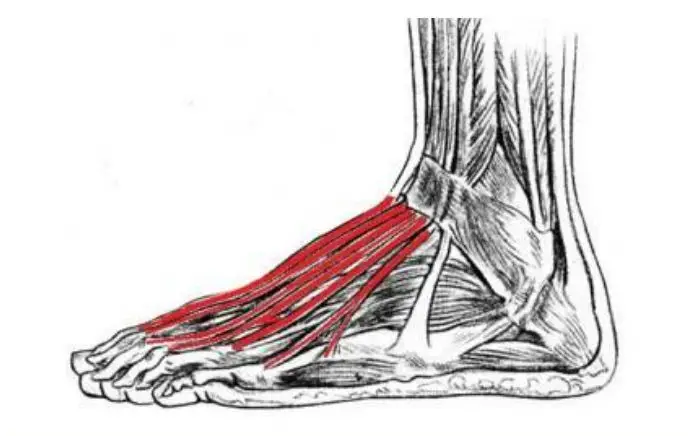EXTENSOR TENDONITIS
Pain Across The Top Of The Foot
Extensor tendonitis is a common cause of pain on the top of the foot, often triggered by repetitive stress, tight footwear, or overuse injuries. This condition affects the tendons responsible for lifting the toes, leading to inflammation, tenderness, and discomfort with walking or pressure from shoes.
At SoCal Foot and Ankle Doctors, with offices in Santa Monica and the Cedars-Sinai Medical Towers, we provide expert diagnosis and treatment for extensor tendonitis — helping patients return to pain-free activity without unnecessary delay.

What Is Extensor Tendonitis?
The extensor tendons are fibrous tissues that connect the muscles in the front of your lower leg to your toes. Their main job is to lift the toes and foot upward during walking and movement.
The two primary tendons involved are:
- Extensor hallucis longus – lifts the big toe
- Extensor digitorum longus – lifts the second through fifth toes
These tendons travel across the front of the ankle and top of the foot, where they are exposed and have minimal cushioning, making them prone to irritation from pressure or strain.
Causes of Extensor Tendonitis
- Tight or poorly fitting shoes placing pressure across the top of the foot
- Overuse from running, walking uphill, or repetitive foot movements
- Footwear laces tied too tightly
- Ankle sprains or prior foot trauma
- Flat feet or gait abnormalities that increase stress on the extensor tendons
Symptoms of Extensor Tendonitis
- Sharp or aching pain across the top of the foot
- Increased pain with walking, standing, or wearing shoes
- Swelling or tenderness along the top of the foot or ankle
- Discomfort when flexing the foot or toes upward
- Pain that improves with rest and worsens with activity
Diagnosis and Evaluation
Our podiatrists perform a thorough clinical exam to evaluate:
- Location and pattern of pain
- Range of motion and tendon function
- Gait and foot mechanics
In some cases, X-rays, ultrasound, or MRI may be ordered to rule out fractures, joint issues, or other soft tissue injuries.
Extensor Tendonitis Treatment in Santa Monica & Cedars-Sinai
Most cases of extensor tendonitis respond well to non-surgical treatment, especially when caught early. At SoCal Foot and Ankle Doctors, we develop personalized treatment plans focused on long-term relief and function.
Conservative Treatment Options:
- Rest and activity modification
- Ice therapy to reduce swelling
- Anti-inflammatory medications
- Shoe modifications or switching to more supportive footwear
- Orthotic inserts to correct underlying biomechanics
- Physical therapy and gentle stretching exercises
In rare cases where the condition becomes chronic or resistant to conservative care, advanced interventions such as platelet-rich plasma (PRP) or ultrasound-guided injections may be considered.
Don’t Let Foot Pain Limit You
If you’re experiencing persistent pain across the top of your foot, schedule a consultation at SoCal Foot and Ankle Doctors. Our clinics in Santa Monica and the Cedars-Sinai Medical Towers are trusted by patients throughout West Los Angeles for providing compassionate, results-driven foot and ankle care.
Our Docters
Our Board Certified Podiatrists
Socal Foot and Ankle doctors are committed to delivering the most exceptional treatments.

Board Certified Foot & Ankle Specialist
Office Time
Location: Santa Monica
Mon – Thur: 9:00 AM – 5:00 PM
Friday: 9:00 AM – 5:00 PM

Board Certified Foot & Ankle Specialist
Office Time
Location: Santa Monica
Mon – Thur: 9:00 AM – 5:00 PM
Friday: 9:00 AM – 5:00 PM
Request Appointment
NON-INVASIVE ADVANCED TREATMENT
BOARD CERTIFIED
FOOT & ANKLE
Surgeons
Years Experience
Happy Patients
Location
Local Partners
